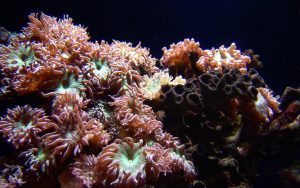This post may contain affiliate links. As an amazon associate I earn from qualifying purchase. Learn more
You’ve probably come across this article because you wanted to learn about the Duncan Coral.
You are in the right place.
I’ve made the assumption that you don’t know anything about Duncan corals. But, you are eager to learn.
That’s why I made this guide as simple as possible, including only the essential information. However, don’t be fooled. Despite its simplicity, this manual is everything you need to know about how to take care of the Duncan coral.
The goal of this guide is not only to teach about general Duncan coral care, but its placement, lighting, and possible problems you may encounter, as well.
Sounds good?
Let’s get started.

Contents
Duncan Coral Care
The Duncanopsammia axifuga, commonly referred to as the Duncan Coral, or Whisker coral is popular coral in the aquarium trade.
It’s usually found in Australia and the South China Sea growing in colonies, where it inhabits reefs with low current water, at depths up to 100 feet.
The Duncan Coral strongly resembles zoanthids or other button polyp types, however, it’s part of the Large Polyp Stone (LPS) coral species. It’s one of the most popular corals in the aquarium hobby, and it’s easy to see why. It’s relatively easy to take care of, it grows in fast rates, and you won’t have a problem to propagate it.
It’s used to be very difficult to find this particular coral in the United States, however, now, thanks to the coral farms, it is available in almost every local fish store.
If you have any doubts regarding their aggressiveness, I can say only one thing. This is a peaceful coral. You won’t have problems keeping it with other non-aggressive species. Of course, if you provide them with enough space to grow (more on that later in this article).
Like any other LPS corals, they benefit from the addition of other trace elements such as calcium and strontium.
Placement
Duncan corals grow fast. Suppose they are well-fed, of course. That’s why it is so important to plan where to place them. Make sure that you provide them with enough space for growing.
It won’t be a problem to keep them with other species as long they have enough room.
Mostly, where you place your corals, depends on lighting and flow. Let’s see why?
Lighting & Flow
These corals are amazing. And I’ll tell you why. They have low to moderate lighting requirements, which make them perfect for beginners. Or for those that don’t like to invest too much on lighting and went on the budget side of the hobby.
However, be careful when you are introducing the Duncan coral for the first time in your tank. Experiment until you find the perfect spot, whether is in lower areas or higher areas of your tank.
In the ocean, these types of corals inhabit low current waters. However, in the tank is better to have low to moderate current to easier bring them food such as phytoplankton and zooplankton.
Feeding
The Duncan Coral is not different from the other Large Polyp Stone (LPS) corals. It has similar feeding requirements. As a photosynthetic coral, It gets most of its nutrients from the lighting in your aquarium. That’s the first source, which without it, no Duncan coral can survive. So if you have proper lighting in your tank you are good to go.
However, the Duncan coral will have a faster growth rate if additional feeding is added. What do I mean by that?
Duncan corals are photosynthetic, but they are also hunters. In the wild, they are capable of catching prey and eating it. That’s why is so important to target feed them once in a while, mostly brine shrimp and enriched Mysis.
FAQs
Are Duncan corals easy to keep?
Duncan corals are one of the easiest LPS corals you can keep in a reef tank. They have low to moderate lighting requirements, are not expensive, and have a beautiful appearance, making them an excellent choice for beginner reefers.
Does Duncan coral sting?
Duncan corals are known for extending their tentacles to collect food. If there are other types of corals near them, they could potentially touch or sting them. That’s why the best practice is to give your Duncan corals plenty of space.
Do you want to know more about other types of corals? Check our other coral guides!
- Elegance Coral Care Guide
- Torch Coral Care Guide
- Hammer Coral Care Guide
- Bird Nest Coral Care Guide
- Zoanthid Coral Care Guide
Final Thoughts
Taking care of corals is a wonderful hobby by itself. Starting out with easier LPS corals at the beginning is the best practice to prevent losing motivation down the road. The Duncan coral is the perfect candidate for that.
Easy to take care of, beautiful, and with low light requirements, the Duncan coral is a perfect addition to every reef tank.
Now, I’d like to hear from you.
What’s your experience with Duncan corals? Do you have any problems? Or keeping these types of corals is a piece of cake?
Let me know in the comments below.
Featured Image: Source
I have a Duncan coral that was thriving. But it closed up about 2 or 3 months ago. It is not happy. I do not want it to die. What can I do?
Duncans are sensitive corals. Check your water chemistry and see if everything is on point.
Thank you. Nice, informative article.